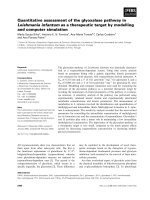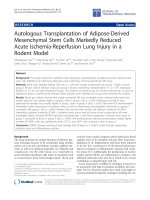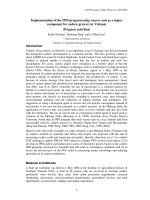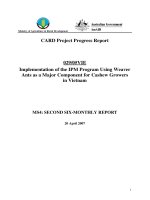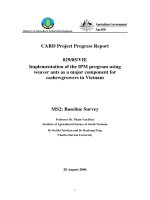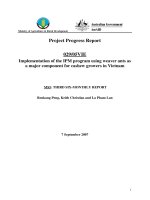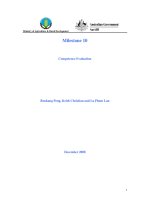Use of IPs cell derived neural stem cells as a cellular vehicle for glioma and breast cancer therapy
Bạn đang xem bản rút gọn của tài liệu. Xem và tải ngay bản đầy đủ của tài liệu tại đây (3.66 MB, 134 trang )
1
USE OF iPS CELL-DERIVED NEURAL STEM CELL AS A
CELLULAR VEHICLE FOR GLIOMA AND BREAST
CANCER THERAPY
ESTHER LEE XING WEI
(B,Biomed Sci., University of Melbourne)
A THESIS SUBMITTED
FOR THE DEGREE OF DOCTOR OF PHILISOPHY
DEPARTMENT OF BIOLOGICAL SCIENCES
NATIONAL UNIVERSITY OF SINGAPORE
&
INSTITUTE OF BIOENGINEERING AND
NANOTECHNOLOGY (A*STAR)
2011
2
ACKNOWLEDGEMENTS
First and foremost I would like to thank A/P Wang Shu for his
scientific support and guidance. The members of our lab: Ghayathri
Balasundaram, Xiaoying Bak, Yukti Choudhury, Timothy Kwang, Dang
Hoang Lam, Jiakai Lin, Seong Loong Lo, Yovita Ida Purwanti, Chrishan
Julian Alles Ramachandra, Mohammad Shahbazi, Chunxiao Wu, Kai Ye,
Ying Zhao, Jieming Zeng and Detu Zhu have been invaluable resources,
not only for their technical help, tips and advices but also the camaraderie.
I am grateful for my family, especially my husband and son who
have been with me through the tough times. They have been nothing but
supportive in all my endevaours. Finally and most importantly,I would also
like to thank God for His countless grace.
3
LIST OF PUBLICATIONS
E. X. W. Lee, D.H. Lam and S.Wang. iPS-cell derived Neural Stem Cell for
Glioma Therapy. Poster presentation. World Stem Cell Summit, Detriot, USA,
2010.
X. Y. Bak, D. H. Lam, J. Yang, K. Ye, E. X. W. Lee, S. K. Lim and S. Wang,
"Human Embryonic Stem Cell-Derived Mesenchymal Stem Cells as Cellular
Delivery Vehicles for Prodrug Gene Therapy of Glioblastoma," Human Gene
Therapy, (2011)
E. X. W Lee, D.H. Lam, C.X. Wu, J. Yang, C.K. Tham, W.H. Ng and S. Wang.
Glioma Gene Therapy Using Induced Pluripotent Stem Cell Derived Neural Stem
Cells. Molecular Pharmaceutics , Oct 3;8(5):1515-24Jul 22,2011.
E. X. W. Lee, Y. Kai, G. Balasundaram, F. Tay, S.Goh, S. Wang.
Comparison of three suicide gene/prodrug systems in cancer gene therapy
mediated by baculovirus-transduced neural stem cells derived from human
pluripotent stem cells. Poster presentation. Stem Cell Society Singapore
Symposium 2011.
4
TABLE OF CONTENTS
1. Introduction.
1.1 Glioblastoma. 13
1.2 Breast cancer. 13
1.3 Gene therapy: the methods of gene transfer. 14
1.3.1 Viral vectors. 14
1.3.1.1 Adenovirus. 15
1.3.1.2 Retrovirus. 16
1.3.1.3 Baculovirus. 16
1.3.2 Synthetic vectors. 18
1.3.3 Molecular approach for cancer gene therapy. 18
1.3.3.1 Prodrug converting/suicide gene therapy. 18
1.3.3.2 Expression of molecules that affect angiogenesis, tumor
invasion and metastasi. 20
1.3.3.3 RNA interference (RNAi) targeting approach. 21
1.3.4 Immunomodulation approach to cancer gene therapy. 21
1.3.5 Current status of gene therapy for glioma and breast cancer. 22
1.4 Stem cells. 23
1.4.1 Adult stem cells. 24
1.4.1.1 Neural stem cells. 24
1.4.2 Induced pluripotent stem cells. 25
1.5. Stem cell as a vehicle for cancer gene therapy. 26
1.5.1 Stem cell based cancer gene therap. 26
5
1.5.2 Cancer tropism of stem cells. 27
1.5.3 Route of administration of stem cell. 28
1.5.4 Clinical trials with stem cell based cancer gene therapy. 28
1.5.5 Future of stem cell based cancer gene therapy. 30
2. Aims and objective. 31
3. Material and methods. 33
3.1 Cell culture. 33
3.2 Mouse iPSC-derived NSC for glioma therapy. 34
3.2.1. Lentivirus preparation, reprogramming and maintenance of mouse
iPSC. 34
3.2.2 Alkaline phosphatase staining. 36
3.2.3 Generation of mouse iPSC-derived NSC (msiPSC-NSC) 36
3.2.4 Characterization of msiPSC-NSC. 37
3.2.5 RT
2
profiler PCR array. 38
3.2.6 Baculoviral vector construction and transduction. 40
3.2.7 Cytotoxicity assay. 40
3.2.8 In vitro migration assay.
3.2.9 In vitro sensitivity of TK expressing-neural stem cells (msiPSC-
NSCtk) to GCV. 42
3.2.10 In vitro tumoricidal effect in glioma cells. 42
3.2.11 Animal study design: the use of msiPSC-derived NSC for glioma
therapy. 42
6
3.3 Comparison of different delivery methods of stem cells in breast cancer
mouse model. 43
3.3.1 Derivation, maintenance of iPSC-NSC. 43
3.3.2 Characterization of iPSC-NSC. 44
3.3.3 Fluorescence labelling and biocompatibility analysis. 45
3.3.4 Animal study design: comparison of different delivery methods. 45
3.4 Comparison of 3 suicide gene systems: HSVtk, Fcy and CodA. 46
3.4.1 Baculovirus preparation and cell transduction. 46
3.4.2 In vitro sensitivity of HSVtk, Fcy and CodA-expressing
iPSC-NSC. 47
3.4.3 Animal study design: comparison of 3 prodrug systems in 4T1
breast cancer mouse models. 49
4. Results.
4.1 Use of msiPSC-NSC in glioma therapy. 50
4.1.1 Aim. 50
4.1.2 Reprogramming of mouse embryonic fibroblasts to induced
pluripotent stem cells and the derivation of neural stem cells. 50
4.1.3 msiPSC-NSC display migratory behavior to glioma. 57
4.1.4 msiPSC-NSC can be successfully transduced with baculovirus. 59
4.1.5 msiPSC-NSCtk generated by baculoviral transduction display
bystander killing effects on glioma cells in vitro. 65
4.1.6 Gene therapy using HSVtk-expressing NSCs in glioma mouse model
successfully reduces tumor growth rate. 67
7
4.2 Comparison of different stem cell delivery methods in breast cancer mouse
model. 67
4.2.1 Aim 67
4.2.2 DiR labeled iPSC-NSC as a tool for tracking stem cell migration in
vivo. 67
4.2.3 iPSC-NSC injected intravenously exhibits observable but limited
migration to mammary fatpad tumor in vivo. 69
4.2.4 Baculovirus successfully transduces iPSC-NSC. iPSCNSCtk/GCV
exhibits breast cancer therapeutic effect. 73
4.3 Comparison of 3 suicide gene systems: HSVtk, Fcy and CodA. 76
4.3.1 Aim. 76
4.3.2 iPSC-NSC transduced with baculovirus carrying herpes simplex
virus thymidine kinase or cytoskine deaminase are sensitive to GCV
and 5’-FC respectively. 76
4.3.3 A small population of suicide gene carrying cells is sufficient to elicit
bystander mediated killing effect. 80
4.3.4 CD/5-FC system shows slightly better therapeutic effect in 4T1
breast cancer mouse in vivo. 82
5. Discussion 86
5.1 Use of msiPSC-NSC in glioma therapy. 86
5.1.1 NSCs as a suitable gene delivery vehicle for glioma therapy. 86
5.1.2 The population size of NSC is a limiting factor for gene delivery. 87
5.1.3 Using baculoviral vector for gene transfer. 89
8
5.1.4 The immunomodulatory effects of NSCs. 90
5.1.5 The suitability of U87 glioblastoma model as a tool for studying
glioma therapy in vivo. 92
5.2 Comparison of different stem cell delivery methods in breast cancer mouse
model. 92
5.2.1 Issues regarding the different methods of stem cell
administration. 93
5.2.2 DiR as a suitable label for in vivo tracking of iPSC-NSC. 94
5.3 Comparison of 3 suicide gene systems: HSVtk, Fcy and CodA. 95
5.3.1 HSVtk/GCV and CD/5-FC mediates bystander effect by different
methods. 96
5.3.2 Tumor growth rates were reduced but no complete eradication of
cancer was observed. 98
5.3.3 Possible strategies to improve therapeutic efficiency. 98
5.3.4 Possible cytotoxic side effects from prodrug treatment. 100
6. Conclusion 101
7. Future Direction 106
9
Summary
Using neural stem cells with tumor tropic migratory capacity to deliver therapeutic
genes is an attractive strategy in eliminating metastatic or disseminated tumor.
Different methods have been studied and developed to isolate or generate NSCs,
but it has not been assessed whether induced pluripotent stem cells (iPSCS), a
type or pluripotent stem cells that hold great potential for regenerative medicine,
can be used as a source for derivation of NSCs with tumor tropism. In this study,
we used a conventional lentivirus transduction method to derive both mouse and
human iPSCs from embryonic fibroblasts and then generated NSCs from these
iPSCs. To investigate whether the iPSC-derived NSCs can be used in the
treatment of disseminated brain tumor and metastatic breast cancer, the cells
were transduced with baculoviral vector containing the herpes simplex virus
thymidine kinase or the cytosine deaminase suicide gene. In the glioma study,
the mouse iPSC-NSCtk were injected contralaterally to tumor inoculation site in a
mouse intracranial human glioma xenograft model. In the breast cancer study,
the human iPSC-NSCtk, iPSC-NSCFcy, iPSC-NSCCodA were injected either
intravenously or directly into the tumor site. We observed that NSCs expressing
the suicide gene were, in the presence of respective prodrugs ganciclovir or 5-
fluorocytosine, effective with varying extents in inhibiting the cancer development
of the glioma xenograft and breast cancer metastatic model and prolonging the
survival of tumor-bearing mice. Our findings provide evidence for the feasibility of
using iPSC derived NSCs as a vehicle for targeted anticancer gene therapy.
10
LIST OF TABLES
Table 1. RT-PCR primer sequences for pluripotent stem cell “stemness”-specific
and neural stem cell-specific markers. 57
Table 2. Changes in expression of embryonic stem cell-specific markers and
embryonic stem cell differentiation/lineage marker genes between msiPSCs and
MEFs. 58
11
LIST OF FIGURES
Figure 1. Generation of iPS cells from mouse embryonic fibroblasts (MEFs). 55
Figure 2. Generation of neural stem cells from mouse iPS cells and
characterization of derived NSCs 56
Figure 3. in vivo and in vitro migratory behaviour of msiPSC-NSC to glioma. 60
Figure 4. Mouse iPS cell-derived NSCs can be used to deliver HSVtk suicide
gene using a baculoviral vector. 64
Figure 5. in vitro bystander killing effect of msiPSC-NSCtk. 65
Figure 6.HSVtk/GCV gene therapy for glioma mediated by msiSPC-NSC. 68
Figure 7. Characterization of iPSC-NSC labeled with DiR 70
Figure 8. Biodistribution of intravenous administered iPSC-NSC in breast cancer.
73
Figure 9. Confocal Imaging of DiR labelled iPSC-NSC ex vivo. 74
Figure 10. in vivo tumor monitoring of breast cancer development, and
comparison of the therapeutic effect of different administration methods of stem
cells. 77
Figure 11. iPSC-NSC transduced with baculovirus expressing HSVtk, Fcy and
CodA. 80
Figure 12. Dose-dependent response of suicide gene-transduced iPSC-NSC to
prodrugs. 81
Figure 13. Sensitivity of bystander mediated killing effects of HSVtk/GCV, Fcy/5-
FC and CodA/5-FC in co-culture experiments. 83
12
Figure 14. HSVtk/GCV and CD/5-FC for breast cancer therapy mediated by
iPSC-NSC. 86
Figure 15. Survival analysis of breast cancer receiving HSVtk/GCV or CD/5-FC
treatment mediated by iPSC-NSC 87
13
ABBREVIATIONS
5-FC
5-Fluorocytosine
5-FU
5-Fluorouracil
AAV
Adeno-associated virus
ADA-SCID
Adenosine Deaminase Severe Combined Immunodeficiency
Disease
AP
Alkaline phosphatase
ASC
Adult stem cell
AV
Adenovirus
bFGF
Basic Fibroblast Growth Factor
BLI
Bioluminescent
BV
Baculovirus
CD
Cytosine Deaminase
DC
Dendritic Cells
DMEM
Dulbecco's Modified Eagle Medium
EGF
Epidermal Growth Factor
FBS
Fetal Bovine Serum
FCS
Fetal calf serum
GBM
Glioblastoma Multiforme
GCV
Ganciclovir
hESC
Human embryonic stem cell
hESC-NSC
Human embryonic stem cell-derived neural stem cell
HSVtk
Herpes simplex virus thymidine kinase
IL
Interleukin
IP
Intraperitoneal
iPSC
human induced pluripotent stem cell
iPSC-NSC
human induced pluripotent stem cell derived-neural stem cell
iPSC-
NSCCodA
human induced pluripotent stem cell derived-neural stem cell
expressing CodA
iPSC-
NSCFcy
human induced pluripotent stem cell derived-neural stem cell
expressing Fcy
iPSC-
NSCtk
human induced pluripotent stem cell derived-neural stem cell
expressing HSVtk
LIF
Leukemia inhibitory factor
MEF
Mouse embryonic fibroblasts
miRNA
Micro RNA
MMLV
Moloney murine leukemia virus
MSC
Mesenchymal stem cell
msiPSC
Mouse induced pluripotent stem cell
msiPSC-
NSC
Mouse induced pluripotent stem cell-derived neural stem cell
NIR
near-infrared
NSC
Neural stem cell
RT-PCR
Reverse Transcription PCR
siRNA
small interfering RNA
14
1.1 Glioblastoma
Malignant brain tumors such as glioblastoma multiforme (GBM) and childhood
brain cancer, medulloblastoma, have remained virtually untreatable and lethal.
The median survival is 1 year or less for GBM (Black PM and Loeffler J, 2005;
Packer et al., 1999). Current treatment involving radical surgical resection,
followed by radiation and chemotherapy substantially improves the survival rate
in some patients, however it remains incurable in a large proportion of patients
due to its exceptional ability in infiltrating into surrounding neural tissues distinct
from primary tumor localization. These microsatellites then act as seeds for
recurrent tumor growth (Claes A et al., 2007; Jeon JY et al., 2008).
1.2 Breast cancer
Breast cancer is the most common female malignancy diagnosed in women in
developed nations, with an estimated 208,000 women diagnosed with this
disease in the United States alone in 2010 (Jemal A et al., 2010). Breast cancer
is a heterogeneous entity with distinct subsets characterised by differences in
tumor biology and response to therapy. The majority of breast cancers are
estrogen receptor -and/or progesterone-positive, and approximately one in five
breast cancers is human epidermal growth factor receptor 2/erb-B2 (HER2)-
positive breast cancers. Hormone receptor-positive and HER2-positive breast
cancers have highly effective targeted treatments available. Triple-negative
breast cancer (TNBC) accounts for 15% to 20% of breast cancers (Konecny G.
15
et al., 2003). Therapy for TNBC is empiric and not based on tumor biology, thus
increasing the risk of toxicity without potential benefit. As these cancers have a
high risk of relapse, irrespective of grade and stage, they account for a large
proportion of metastatic breast cancers (Irvin WJ and Carey 2008). 4T1
mammary carcinoma cell line is a suitable experimental animal model for human
mammary cancer. When introduced orthotopically, it is capable of metastasis to
several organs affected in breast cancer including lungs, liver, brain and bone
(Aslakson CJ and Miller FR 1992; Yoneda T et al., 2000; Eckhardt BL et al.,
2005).The progressive spread to the organs and draining lymph nodes is very
similar to that of human mammary cancer (Pulaski BA and Ostrand-Rosenberg S
1998).
1.3 Gene therapy: the methods for gene transfer
Gene therapy is the transfer of genetic material into individuals for therapeutic
purposes by altering cellular functions or structure at the molecular level. Gene
therapy can be carried out by three main routes: gene addition, gene
correction/alteration and gene knockdown of which gene addition is the most
commonly attempted (Mark A. Kay 2011). Two general ways to perform gene
therapy: (1) direct in vivo method and (2) an indirect ex vivo method. Gene
delivery methods can be divided into viral methods (lentivirus, adenovirus and
retrovirus) and non viral methods (lipoplexes, naked DNA, RNA).
1.3.1 Viral methods
16
Although non-viral approaches have become more common, two-thirds of gene
therapy clinical trials performed used viral vectors due to the poor transfection
efficiency and relatively low long term transfection rates of non-viral methods
(Edelstein ML et al., 2007).
1.3.1.1 Adenovirus
Adenovirus (AV) is a non-enveloped double stranded DNA viral vector and
currently the most commonly used vector in gene therapy trials (Horne et al.,
1975; Edelstein ML et al., 2007).It can be used in either replication deficient or
replicating forms (Chiocca et al., 2003). Replicating viruses are oncolytic,
selectively lysing and dividing tumor cells, and there have been ways to engineer
replicating oncolytic virus to achieve tumor selectivity. Onyx-015 and Ad5-
Delta24 are 2 widely studied oncolytic AV.
Onyx015 has deletion in E1B55K gene that allows its replication in p53
defective tumor cells specifically, and its tumor-specific lysis has been enhanced
in clinical trials when combined with chemotherapy in brain, neck and
gastrointestinal cancers (Heise et al., 1997; Jiang G et al, 2011). AV mutated in
E1A and E1B showed significant antitumor effect in intracranial glioma
xenografts with increase tumor selectivity (Gomes-Mazano et al., 2004).
The main advantage of adenoviral vectors are their high efficiency of
transduction, ability to infect dividing and non-dividing cells without risk of
insertional mutagenesis as they remain as an episomal element after infection,
larger DNA load than retrovirus and high level of gene expression, though this is
17
transient and declines fairly rapidly (Immonen et al, 2004; Edelstein ML et al.,
2007). A major disadvantage of adenoviral vectors lies in the activation of both
the innate and adaptive parts of the recipient's immune system when applied in
vivo. This immune response may provide additional antitumor effects in glioma
treatment (Sandamair et al., 2000).However, the inflammatory responses can be
very strong and can be fatal in patients treated with these AV constructs (Ritler T
et al., 2002).
1.3.1.2 Retrovirus
Retroviruses are RNA viruses that carry a gene for reverse transcriptase that
transcribe viral gene material into double-stranded DNA intermediate. This DNA
intermediate can stably integrate into host DNA, passing to all daughter cells
derived from transfected cell (Goff and Lobel, 1987; Oligino et al.,2000). There
are two main types of retrovirus employed: lentivirus and Moloney murine
leukemia virus (MMLV), with the MMLV more utilised in clinical trials (Marshal
2002). However there is no guarantee that integrated DNA sequences will not
cause mutations or malignancies, and its use is also limited by the vector’s
inability to infect non-dividing cells and low transduction efficiency (Rainov and
Ren 2003).
1.3.1.3 Baculovirus
The insect baculovirus Autographa californica multiple nucelopolyhedrovirus
(acMNPV)-based vector with a circular double-stranded DNA genome has
18
recently been introduced as a delivery vehicle for transgene expression in
mammalian cells, It is capable of transducing MSCs, MSC-derived adipogenic,
osteogenic and chondrogenic progenitor cells, hESCs and primary neural cells
with varying extents of transduction efficiency. Baculovirus mediated transduction
had no significant effect on the characteristics of the cells (Ho Y-C et al., 2005;
Ho Y-C et al., 2006; Zeng J et al,2007). Commonly used gene therapy viral
vectors such as retrovirus, lentivirus, adenovirus and adeno-associated virus
(AAV) in nature have evolved efficient pathways for cellular uptake and viral gene
expression (Mark A Kay 2011). However, retroviral and lentiviral vectors
randomly integrate into the host genome and has resulted in malignant
development (Hacein-Bey-Abina S et al., 2003). The immune response elicited
by adenovirus has hindered its development as a suitable vehicle for gene
therapy (Ritler T et al., 2002) and although AAV confers long-term expression as
compared to baculovirus’ transient expression, it has limited 2.5-4kb cloning
capacity and inconvenient scale up production. Furthermore, the majority of
human population has been exposed to adenovirus and AAV infections, thus pre-
existing immunity might limit its application (Bangari DS and Mittal SK, 2006;
Zaiss AK and Muruve DA, 2005). As compared to adenovirus and AAV,
baculovirus is an insect virus and humans do not appear to possess pre-existing
antibody and T-cell specifically against baculovirus. Baculovirus does not
integrate into the genome, replicate or is toxic in transduced cells. In addition, the
construction, propagation and scaling up of baculovirus can be performed easily
(Hu YC 2008).
19
1.3.2 Synthetic vectors
The limitations of viral vectors, their relatively small capacity for therapeutic DNA
and in particular the safety concerns have prompted the development of
synthetic vectors not based on viral systems. The popularity of this method was
reflected in the slight increase of its use in clinical trials (Edelstein ML et al.,
2007). This system consists of the ‘naked’ DNA with the delivery constituent. To
create delivery platforms, DNA has been complexed to many different types of
macromolecules eg. polysaccharides, poly-lysine, poly-ethylenimine, but the
delivery efficiency has remained poor and expression does not persist for
sufficiently long periods. Hence this approach can only prove useful if the
problems associated with delivery efficacy can be overcome (Kay MA 2011).
1.3.3 Molecular approaches for cancer gene therapy
The molecular approach for cancer gene therapy is divided mainly into the
several groups. Firstly, suicide gene therapy which targets cancer cells at
molecular levels. Secondly, genes involved in cancer development, tumor
invasion and metastasis and thirdly, RNAi that employs oligonucleotides that can
bind to specific RNA or DNA sequences.
1.3.3.1 Prodrug converting/suicide genes
Suicide gene therapy involves delivery of a specific enzyme that can produce cell
death through conversion of an inactive non-toxic prodrug into a cytotoxic drug
20
metabolite. Prodrug-activating enzymes are normally absent or poorly expressed
in mammalian cells. The tumor targeting of gene therapy uses specific delivery
vehicles that restricts enzyme expression to the transduced tumor cells and
adjacent surrounding tumor cells through diffusion or formation of gap junctions
of drug metabolite to generate a bystander effect. Two systems studied
extensively are the cytosine deaminase/5-fluorocytosine (CD/5-FC) and herpes
simplex virus thymidine kinase/ganciclovir (HSVtk/GCV) system.
CD has been identified in two forms: yeast CD (Fcy) and E.coli CD (CodA).
The CD/5-FC enzyme/prodrug system utilises the diffusion method. It converts
the antifungal agent, 5-FC, to diffusible, highly cytotoxic compound 5-fluorouracil
(5-FU). Intracellular 5-FU is then converted to active metabolites 2-fluoro-2-
dUMP (FdUMP) which is an inhibitor of thymidylate synthase and hence of DNA
synthesis by deprivation of deoxy-thymidine triphosphate (dTTP). 5-FU although
effective in treatment of brain metastasis, cannot penetrate the blood brain
barrier. Hence stem cell driven prodrug cancer therapy is a much more efficient
delivery method. This is further elaborated in section 3.1.
The cytotoxicity towards glioma cells is enhanced by a bystander effect
when NSCs are armed with suicide genes CD and HSVtk (Aboody K.S. et al.,
2000; Li S. et al., 2005; Uhl M. et al., 2005). HSVtk mediates GCV activation in
several sequential phosphorylation steps to GCV 5’-triphosphate, which
21
competes with dGTP for incorporation into DNA in internucleotide linkages
(Rubsam LZ et al., 1998; Cheng YC et al., 1983). In animal studies, the treated
group display significantly extended lifespan and reduction in tumour mass. In
the HSVtk/GCV system, this cytotoxic bystander effect is based on
phosphorylated GCV as a cytotoxic metabolite transferred from cell to cell via
gap junctions (Uhl M. et al., 2005).
1.3.3.2 Expression of molecules that affect angiogenesis, tumor invasion
and metastasis
Angiogenesis is a good target for cancer gene therapy as solid tumors are limited
in size without sufficient oxygen and nutrition. Commonly used anti-angiogenic
genes are vascular endothelial growth factor (VEGF) receptors and angiostatin.
Ribozymes or antisense strands can be used against angiogenic gene products
of tumor cells (Folkman J 2002). Genes involved in invasion and metastasis are
either deficient (eg. TIMP-1) or are overexpressed (eg. metalloproteinase
enzymes). Vectors expressing TIMP-1 or antagonists of metalloproteinases can
Adapted from: www.invivogen.com
22
be potentially used to block the invasion and metastasis of cancer. Antisense
oligonucleotides against mRNA of Bcl-2, c-myc and ras family of oncogenes has
resulted in tumor growth inhibition in solid tumors and leukemia (Marcucci et al.,
2003; Scharovsky et al., 2000).
1.3.3.3 RNA interference (RNAi) targeting
RNAi is a RNA dependent, gene silencing process that exerts its gene silencing
effect through chromatin remodelling, blocking protein synthesis and cleaving
specifically targeting mRNA, either via the engagement of small inhibitory or
interfering RNA (siRNA) or microRNAs (miRNA). Studies that compare normal
versus cancer cells have discovered miRNAs that are implicated in growth
control, angiogenesis and metastasis of cancer. The use of RNAi in probing the
functions of various genes in several tumors has also facilitated the systemic
search for new drug targets (Eis et al., 2005; Liu et al., 2003). The ability of RNAi
to silence disease-associated genes in animal models has shown much promise
for RNAi-based reagents for clinical applications to treat cancer. siRNAs are
readily synthesized with low production costs compared to protein or antibody
therapies. However, their stability in blood and delivery methods are challenges
that must be solved for developing effective RNAi reagents for cancer therapy.
(Kota J et al., 2009).
1.3.4 Immunomodulation approach to cancer gene therapy
23
The failure of normal immune surveillance mechanisms, leading to an inability to
recognize cancer cells as “foreign cells”, is integral in tumor development. Hence
vectors that express genes that activate the host immune system or bypass
some of these defects have been utilized. The genes found to alter the local
immune microenvironment eg. interleukin(IL)-2, IL-4, IL-12, tumor necrosis factor,
interferon-γ, granulocyte-macrophage colony stimulating factor(GM-CSF); and
genes that have immuno-stimulatory activity or T-cell co-stimulatory molecules
are some of them (Rosenberg SA 2004).
1.3.5 Current status of gene therapy for glioma and breast cancer
The first gene therapy clinical trial was conducted in melanoma patients
(Rosenberg et al., 1989) followed by treatment of 2 children with severe
combined immunodeficiency (ADA-SCID) using retrovirus encoding adenosine
deaminase gene (Anderson et al., 1999). Thus far, the majority of clinical trials in
gene therapy have been aimed at treatment of various immunodeficiences,
cancers including lung, skin, gynaecological and neurological diseases (Edelstein
ML et al., 2007). Combining adenoviral vectors expressing granulocyte-
macrophage colony stimulating factor (GMCSF) and a means to restrict vector
replication to tumor cells has proven successful in several different cancer trials
(Koski A et al., 2010; Burke J.M et al., 2010). T-cells engineered to co-express
tumor-specific receptors have also shown persistent antitumor activity in
neuroblastoma patients (Pule M.A et al., 2008).
24
Although gene therapy holds much promise, there have been unfortunate
adverse cases with inevitable effects on progress in this area. Alain Fischer’s
group reported successful treatment of children with X-linked SCID with gene
delivered using retroviral vectors (Cavazzana-Calvo M et al., 2000). 2 of the 10
patients developed leukemia within 3 years of gene therapy treatment due to
retroviral insertion into proximity of the LMO-2 proto-oncogene promoter (Hacein-
Bey-Abina S et al., 2003).
Current gene therapy trials have shown differing extents of anti-tumor
efficiency in clinical studies for malignant glioma. These include the use of
interleukins, interferons in immunotherapy, toxins that target specifically to
surface receptors over-expressed on tumor cells and HSV mutant vectors and
oncolytic conditionally replicating adenoviruses (Rainov NG et al., 2008; Chiocca
EA et al., 2008; Immonen A et al., 2004; Germano IM et al., 2003; Rainov NG
2000). The therapeutic potential for encoding anti-GBM specific siRNA and
miRNA is also being explored (Graner et al., 2009).
A variety of gene therapy approaches have been evaluated for treatment
of breast carcinoma, with majority of clinical trials focusing on p53, and
combining the replacement of p53 function with chemotherapy and radiation
therapy. However varying success have been reported in these clinical trials
(Adis R&D Profile, 2003; Lebedeva S et al., 2001; Nielsen LL et al., 1998). With
respect to suicide gene therapy, a variety of enzyme/prodrug systems have been
investigated in preclinical studies, but those focusing on transducing tumors to
express HSVtk, with systemic administration of GCV have demonstrated varying
25
efficacy as well (Braybrooke JP et al., 2005; Vlachaki MT et al., 2001). Stem cells
as delivery vehicles have been shown to enhance gene delivery efficiency
(elaborated in section 3.1).
1.4 Stem cells
1.4.1 Adult stem cells (ASCs)
Adult stem cells (ASCs), also known as somatic stem cells, are multipotent
undifferentiated stem cells found in a tissue or organ that can renew itself and
can differentiate to yield some or all of the major specialized cell types of the
tissue or organ. Unlike the pluripotent ESCs or iPSCs, ASC proliferation is limited,
making generation of large quantities of stem cells difficult. One of the most-well
studied is the adult hematopoietic stem cells, which give rise to all the blood cells.
Hematopoietic stem cells are in clinical trials for genetic diseases such as sickle
cell, β-thalassemia and multiple sclerosis (Trounson A et al., 2011). Autologous
adipose stem cells and the stromal vascular fractions are being used for soft
tissue engineering in breast augmentation, fistulas in Crohn’s disease (Sullivan
KM et al., 2010).
1.4.1.1 Neural stem cells (NSCs)
NSCs are multipotent cells with the ability to self renew and generate mature
cells in three fundamental neural lineages (astrocytes, oligodendrocytes and
neurons) throughout the nervous system. NSCs for can be derived directly from
the neuroectodermal structures (central nervous system, CNS) or from ES cells

